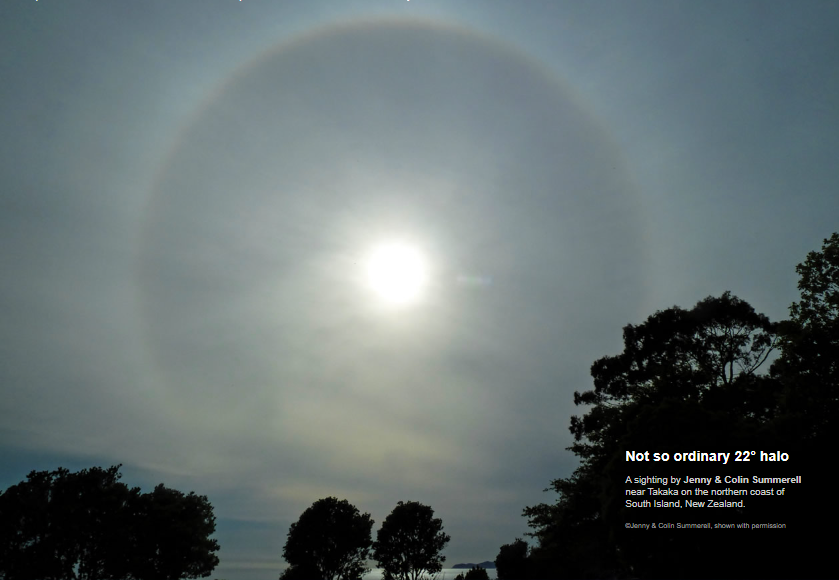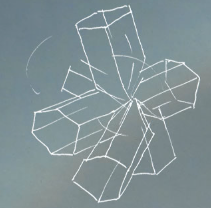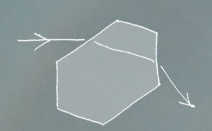22 degree halo and cluster crystals - OPOD
22 Degree Halo and Cluster Crystals: A Mystifying Atmospheric Optics Phenomenon
Atmospheric optics never fails to surprise us with its enchanting displays. One such captivating phenomenon is the 22-degree halo. This halo, often mistaken for the more common high sun circumscribed halo, is a circular band of light that appears around the Sun when certain atmospheric conditions are met. Although it may seem like a routine sight, the 22-degree halo is anything but ordinary.
Unraveling the Mystery of the 22-Degree Halo
The 22-degree halo is formed through the refraction of sunlight by ice crystals in the atmosphere. These crystals, known as cluster crystals, are assemblies of hexagonal columns that tumble and drift downward with the in-cloud air currents. While their exact role in halo formation is still uncertain, they are believed to be a significant source of the 22-degree halo.
To produce the circular shape of the halo, the ice crystal faces must be inclined at an angle of approximately 60 degrees. Furthermore, the face pairs responsible for refraction must be randomly oriented relative to the horizontal plane. This randomness creates the soft pastel colors that are characteristic of the 22-degree halo. In contrast, the high sun circumscribed halo, often mistaken for the 22-degree halo, exhibits sharper and more saturated colors.
The Prevalence of the 22-Degree Halo
Although sundogs may rival its frequency in some regions, the 22-degree halo is considered one of the most common ice crystal halos. In fact, it can be seen on average more than once a week over most of Europe and the less arid parts of North America. Its prevalence makes it a familiar sight to many, yet its formation remains shrouded in mystery.
Unveiling the Crystal Origins
Understanding the crystals responsible for the 22-degree halo is no easy task. While it is known that the halo is produced by the refraction of sunlight through the side faces of hexagonal ice prisms, the crystal orientations pose a challenge. Ordinary hexagonal prism crystals are strongly oriented by aerodynamic drag forces as they drift within clouds or at low levels. Their large hexagonal faces align horizontally, creating a deviation from the necessary random orientation.
To reconcile this discrepancy, scientists have proposed that short equi-dimensional crystals could be responsible for the 22-degree halo. These crystals would tumble and take on all orientations, allowing for the refraction necessary to form the halo. However, crystal samples collected during halo displays do not often exhibit the required equi-dimensional shapes.
The Intriguing Role of Cluster Crystals
In "poor" displays of the 22-degree halo, where it appears predominantly without other halos, clusters of column or bullet crystals are frequently observed. These clusters have the potential to tumble, and refraction through their hexagonal arms can give rise to the 22-degree halo. While this theory remains speculative, it offers a plausible explanation for the prevalence of the halo in certain atmospheric conditions.
The commonness of the 22-degree halo defies its enigmatic origins. This ethereal atmospheric phenomenon continues to fascinate scientists and sky gazers alike, reminding us of the intricate and mesmerizing beauty of our natural world. As researchers delve deeper into the mysteries of atmospheric optics, we eagerly anticipate uncovering the secrets behind this captivating display.

Not so ordinary 22° halo
A sighting by Jenny & Colin Summerell near Takaka on the northern coast of South Island, New Zealand.
©Jenny & Colin Summerell, shown with permission



Cluster crystals, assemblies of hexagonal columns, would tumble as they drift downwards relative to in-cloud air currents.
They might be the source of many 22° halos

The halo is produced by refraction between ice crystal faces inclined 60°. To produce the circle, the face pairs must be near randomly oriented to horizontal
Note the soft pastel colours. Typical of the 22° halo where there is strong colour overlap. The near circular high sun circumscribed halo often mistaken for a 22° has sharper and more saturated colours
The 22° circular halo is oft quoted to be the commonest of the ice crystal halos. Depending on location, sundogs might better claim that title but fragments or complete versions of both can be seen on average more than once a week over most of Europe and the less arid parts of North America.
The 22° halo might be an almost everyday sight but it is by no means ordinary. In one sense it is one of the least ordinary of the halos because we are unsure of what crystals produce it.
The halo, with a bright and pastel coloured inner rim of 22° radius, is certainly produced by refraction of sun rays through the side faces of hexagonal ice prisms with near random orientations. That much we know.
However, ordinary hexagonal prism crystals are strongly oriented by aerodynamic drag forces as they drift within clouds or at low level as diamond dust. Plates have their large hexagonal faces horizontal to within a degree or so. Columns are similarly well oriented with their long axes nearly horizontal.
To overcome these awkward facts, it has been suggested that the 22° halo is created by short equi-dimensional crystals that would tumble and take all orientations. Maybe some are – However, crystal samples taken during halo displays do not have many of the necessary equi-dimensional crystals.
What are often found, especially in ‘poor’ displays showing mainly a 22° halo, are clusters of column or bullet crystals. These would tumble. Refraction through their hexagonal arms would produce the 22° halo.
Maybe – But we are not certain. The commonplace can have less than commonplace cause.
Note: this article has been automatically converted from the old site and may not appear as intended. You can find the original article here.
Reference Atmospheric Optics
If you use any of the definitions, information, or data presented on Atmospheric Optics, please copy the link or reference below to properly credit us as the reference source. Thank you!
-
<a href="https://atoptics.co.uk/blog/22-degree-halo-and-cluster-crystals-opod/">22 degree halo and cluster crystals - OPOD</a>
-
"22 degree halo and cluster crystals - OPOD". Atmospheric Optics. Accessed on November 26, 2024. https://atoptics.co.uk/blog/22-degree-halo-and-cluster-crystals-opod/.
-
"22 degree halo and cluster crystals - OPOD". Atmospheric Optics, https://atoptics.co.uk/blog/22-degree-halo-and-cluster-crystals-opod/. Accessed 26 November, 2024
-
22 degree halo and cluster crystals - OPOD. Atmospheric Optics. Retrieved from https://atoptics.co.uk/blog/22-degree-halo-and-cluster-crystals-opod/.